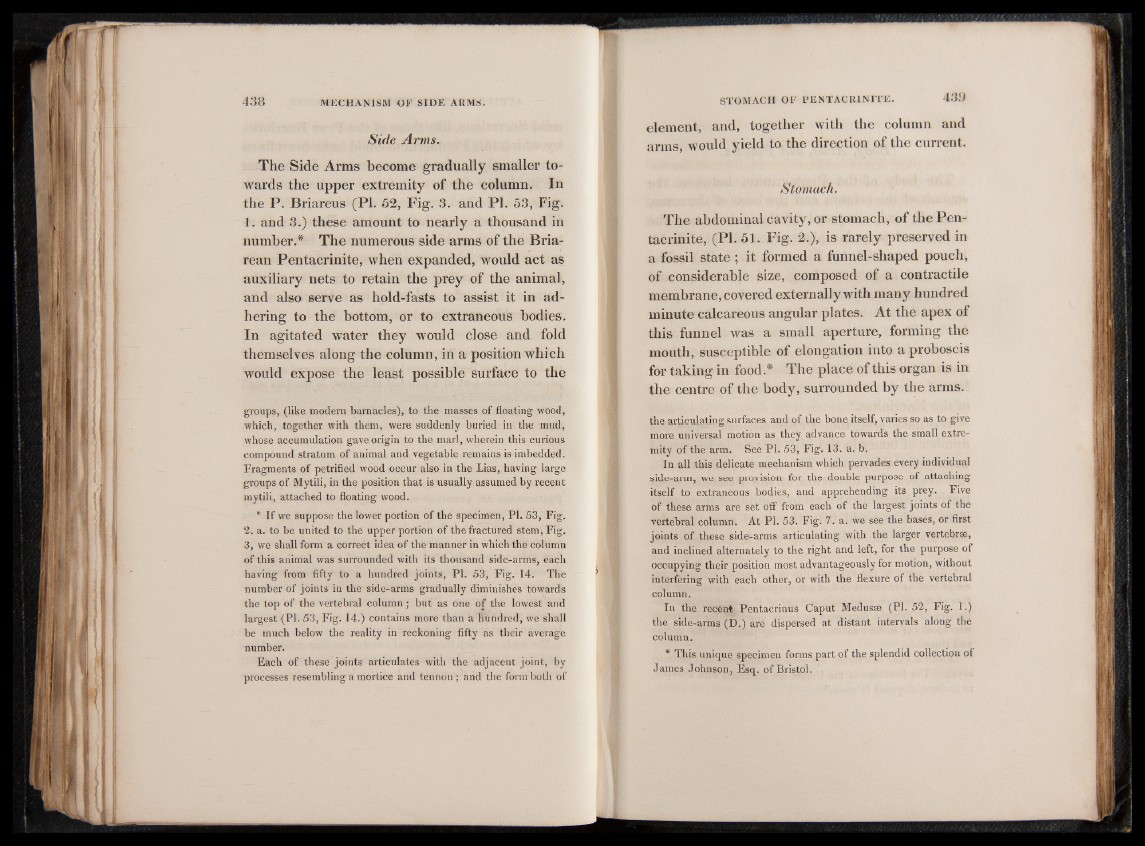
Side Arms.
The Side Arms become gradually smaller towards
the upper extremity of the column. In
the P. Briareus (PI. 52, Fig. 3. and PI. 53, Fig.
1. and 3.) these amount to nearly a thousand in
number.* The numerous side arms of the Bria-
rean Pentacrinite, when expanded, would act as
auxiliary nets to retain the prey of the animal,
and also serve as hold-fasts to assist it in adhering
to the bottom, or to extraneous bodies.
In agitated water they would close and fold
themselves along the column, in a position which
would expose the least possible surface to the
groups, (like modern barnacles), to the masses of floating wood,
which, together with them, were suddenly buried in the mud,
whose accumulation gave origin to the marl, wherein this curious
compound stratum of animal and vegetable remains is imbedded.
Fragments of petrified wood occur also in the Lias, having large
groups of Mytili, in the position that is usually assumed by recent
mytili, attached to floating wood.
* If we suppose the lower portion of the specimen, PI. 53, Fig.
2. a. to be united to the upper portion of the fractured stem, Fig.
3, we shall form a correct idea of the manner in which the column
of this animal was surrounded with its thousand side-arms, each
having from fifty to a hundred joints, PI. 53, Fig. 14. The
number of joints in the side-arms gradually diminishes towards
the top of the vertebral column; but as one of the lowest and
largest (PI. 53, Fig. 14.) contains more than a hundred, we shall
be much below the reality in reckoning fifty as their average
number.
Each of these joints articulates with the adjacent joint, by
processes resembling a mortice and tennon; and the form both of
element, and, together with the column and
arms, would yield to the direction of the current.
Stomach.
The abdominal cavity, or stomach, of the Pentacrinite,
(PI. 51. Fig. 2.), is rarely preserved in
a fossil state; it formed a funnel-shaped pouch,
of considerable size, composed of a contractile
membrane, covered extern ally with many hundred
minute calcareous angular plates. At the apex of
this funnel was a small aperture, forming the
mouth, susceptible of elongation into a proboscis
for taking in food.* The place of this organ is in
the centre of the body, surrounded by the arms.
the articulating surfaces and of the bone itself, varies so as to give
more universal motion as they advance towards the small extremity
of the arm. See PI. 53, Fig. 13. a. b.
In all this delicate mechanism which pervades every individual
side-arm, we see provision for the double purpose of attaching
itself to extraneous bodies, and apprehending its prey. Five
of these arms are set off from each of the largest joints of the
vertebral column. At PI. 53. Fig. 7. a. we see the bases, or first
joints of these side-arms articulating with the larger vertebrae,
and inclined alternately to the right and left, for the purpose of
occupying their position most advantageously for motion, without
interfering with each other, or with the flexure of the vertebral
column.
In the recent Pentacrinus Caput Medusae (PI. 52, Fig. I.)
the side-arms (D.) are dispersed at distant intervals along the
column.
* This unique specimen forms part of the splendid collection of
James Johnson, Esq. of Bristol.